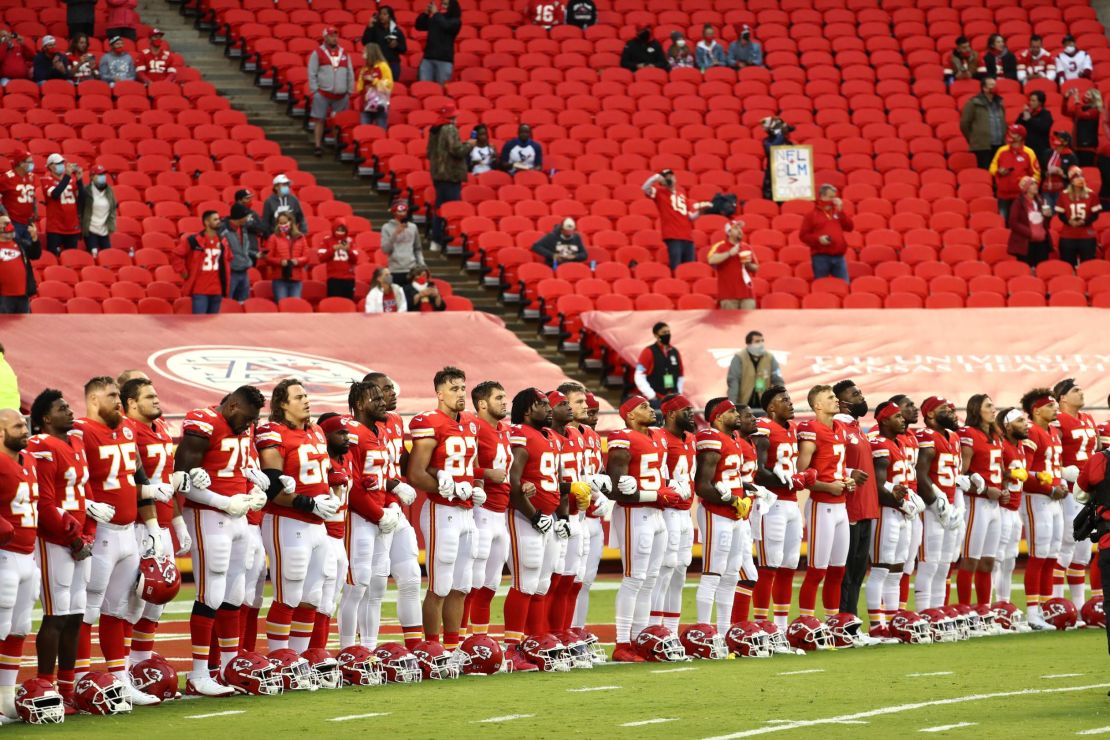In a usual NFL offseason, the news of Patrick Mahomes signing the wealthiest contract in sports history would be one of the biggest – maybe the biggest – stories of the summer for the league .
But as the $450 million man led the Kansas City Chiefs against the Houston Texans on Thursday night in the NFL season opener, a most unusual offseason came to an end and a much different path began in earnest for the country’s most popular sports league. And the news is as focused on the events happening around the players as it is with them.
The visiting Texans and the Chiefs, the defending Super Bowl champion, played in front of a limited crowd, with some key players missing, and with messages in the Arrowhead Stadium end zones calling for social change.
The Chiefs won 34-20.
The last time the NFL played, the world was still fairly normal. It was February 2 and the novel coronavirus was to the American public still mostly a mysterious disease overseas. There were nine confirmed cases in the United States.
When the US declared a public health emergency two days before the Super Bowl, Health and Human Services Secretary Alex Azar said in a statement, “While this virus poses a serious public health threat, the risk to the American public remains low at this time, and we are working to keep this risk low.”
Now, with more than 6.3 million cases and more than 191,000 deaths in the United States, the NFL became the latest sports league to cautiously return to competition arenas.
And it’s not just coronavirus that has changed the football landscape.
The league has taken a titanic shift on racial and social justice issues in light of the killings of Ahmaud Arbery, George Floyd, Breonna Taylor and other people of color. It sees its position as an influencer for social change.
For instance, the Arrowhead Stadium end zones had “End Racism” and “It Takes All of Us” inscribed on the boundary markers near the goal posts.
It’s quite a different tack than in 2016, when Commissioner Roger Goodell and the NFL didn’t support then-San Francisco 49ers quarterback Colin Kaepernick’s kneeling protests against police brutality and racism.

One player – Kansas City linebacker Alex Okafor – knelt Thursday and raised a fist during the National Anthem. Two players put their hands on Okafor’s shoulders. Many Chiefs linked arms with teammates. Others put their right hands over their hearts.
Houston players went to the locker room area.
While the NFL two seasons ago said players must stand or stay in the locker room, Goodell said last month he won’t discipline players for kneeling.
“The NFL stands with the Black community, the players, clubs and fans. Confronting systemic racism with tangible and productive steps is absolutely essential,” Goodell said last week in announcing league initiatives that include the end zone messages. “We will not relent in our work and we will redouble our efforts to be catalysts for the urgent and sustainable change that our society and communities so desperately need.”
Players can wear helmet decals with the names of people killed or wounded in encounters with police and others. The song referred to as the Black national anthem – “Lift Every Voice and Sing” – will play before every game this season. The Texans also remained in the locker room when the song was played Thursday.
There are more than 60 NFL players, including three from the Chiefs and one from the Texans, who have opted to miss every game of the season. That includes Dr. Laurent Duvernay-Tardif, a Chiefs offensive lineman who has recently worked as an orderly in a long-term care facility in Canada and is studying online at Harvard’s school of public health.
“I miss the guys. I miss the contact. But I also know I made, for me, the right decision,” he told Sports Illustrated.
In developing Covid-19 protocols with the players’ union, the NFL made the decision to let teams train in their home cities and play in their own stadiums, a different approach than the NBA “bubble” and the NHL’s hub sites in Edmonton and Toronto.
The NFL tests players every day, according to media reports, citing a league memo. In the latest results, one player and seven team personnel tested positive for the virus between August 30 and September 5, a total of 44,510 tests. Between August 12 and 29, four players tested positive.
The league went without its normal four preseason games, so this will be the first intensive action for players in the past seven or eight months. It also saw training camps where teams had fewer personnel, some meetings went online, players dined solo, and team members used training rooms with tables spread 6 feet apart.
Game day will be different too. Some teams, such as the Chiefs, will allow fans, but most have said they will play at least two home games in empty stadiums. Arrowhead holds 76,000, but only 22% of the seats, about 17,000, were filled Thursday.
Even tailgating will have a coronavirus wrinkle, with vehicles using every other spot and pregame festivities in the parking lot limited to “pods.”
The rest of the NFL plays on Sunday – the Eagles play the Washington Football Team and Tom Brady and the Bucs visit the Saints – and Monday.
CNN’s David Close, Kevin Dotson and Wayne Sterling contributed to this report.







